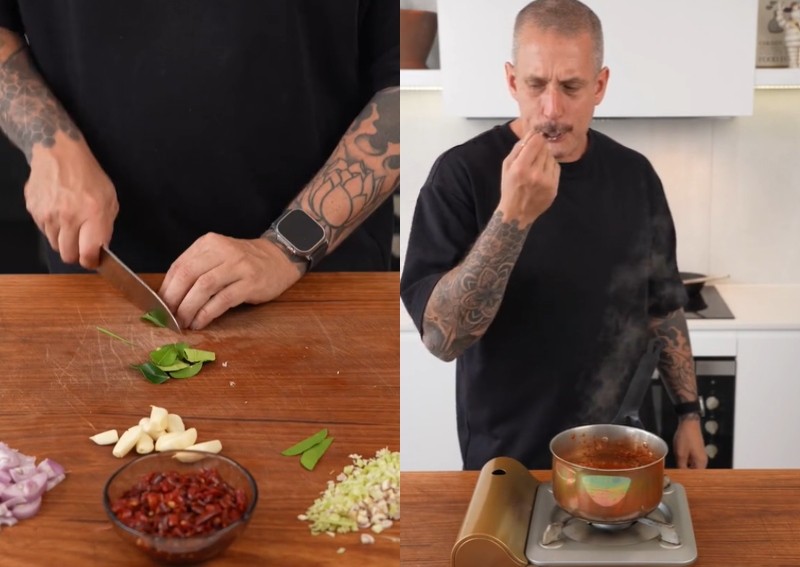'100% fail': New Zealand chef Andy Hearnden's recipe to make nasi lemak sambal sets tongues wagging


 PUBLISHED ONNovember 27, 2023 4:37 AMByAmierul Rashid
PUBLISHED ONNovember 27, 2023 4:37 AMByAmierul RashidSugar, spice and everything nice.
Just a catchy tune from a popular children's TV show... or perhaps the foundation of a good-tasting nasi lemak sambal?
If it's the latter, New Zealand chef Andy Hearnden's recipe might be off the mark, according to some netizens, that is.
Last Sunday (Nov 26), Andy posted a clip on his TikTok account Andy_cooks showing how he makes sambal from scratch.
Despite the professional chef's impressive portfolio of cooking in restaurants around the world, netizens weren't afraid to be brutally honest about his sambal.
@andy_cooks Replying to @zrfazhr Sambal Vote for me for the creator of the year Australia and New Zealand! Link in my bio ✌️ Ingredients - 40 dried chillies - 4 fresh chillies, sliced - 1 stick of lemongrass, diced small - 2 tbsp brown sugar - 3 tbsp tamarind purée - 3 large shallots, sliced - 8 cloves of garlic, peeled and crushed - 50g shrimp paste (Belacan) - 8 kaffir lime leaves, centre stems removed - 3 tbsp peanut oil Method 1. Begin by cutting your dried chillies and letting any seeds fall out, then soak them in enough warm water just to cover for 20 minutes. 2. To toast the shrimp paste, cut it into small cubes, then place it in a dry, medium-sized frying pan. Cook over medium-low heat, breaking it up with a wooden spoon until it dries into a powder. 3. Place everything, apart from the tamarind purée, into a blender and blend until smooth, but not completely. 4. In a saucepan over medium-high heat, add the peanut oil. Once the oil is hot, add the chilli paste you just blended and cook for 8-10 minutes, stirring continuously. 5. Once it's cooked, check for seasoning and add some salt if needed. Then add the tamarind purée, stir well, and check the seasoning again before letting it cool. Store it in the fridge to enjoy whenever you please. 6. This will last safely in your fridge for at least 1 week. You can also break it down into smaller batches and keep it frozen for up to one year. (As a personal note, I've had some in my fridge for a month and still enjoy it, but consume older batches at your own risk!) #cooking #recipe #food #chile #howto #foryou ♬ snooze - sped up audios 🎧
In a separate TikTok video, Andy had whipped up a plate of nasi lemak, but the main question among netizens was how he made the sambal.
The chef gave what the people wanted, providing the full list of ingredients and a step-by-step process to accompany the TikTok video.
Chillies, shallots and garlic are chopped up before being put in a blender with a host of other ingredients including kaffir lime leaves and shrimp paste, locally known as belachan.
The paste goes into a pan with hot peanut oil and that's where salt can be added, if needed.
Tamarind puree comes in last before the cooking process is complete.
"Store in the fridge to enjoy whenever you please," Andy advised.
But based on the ruckus this video has caused online, there are some who might not want to enjoy it at all.
"Before anything else, I'm already afraid to try it. Way too much belachan," one user lamented in Malay.
This sentiment was backed up by a fellow netizen, calling Andy's attempt a "100 percent fail" due to the supposedly large amount of belachan used.
Another common comment was the lack of "pecah minyak" (translates to oil splitting) in the cooking process.
To the uninitiated, this term refers to a stir-frying process of "properly and completely cooking dry chilli paste", according to Singapore food blog Nomadette.
Visually, oil splitting is achieved when oil becomes more apparent and can be seen floating above the paste.
Thankfully for Andy, his attempts received praise as well.


A common feature in certain dishes across Southeast Asia, sambal is believed to have originated in Indonesia, food magazine Bon Appetit noted.
It is often served alongside a meal, to dip or mix (like nasi lemak), for an extra "punch of flavour".
According to Kompas.com, the online portal of a national newspaper in Indonesia, there are more than 200 different types of sambal, each unique to regions and families.
ALSO READ: 'Might be too spicy': 92-year-old Japanese grandma tries nasi lemak for first time
No part of this story or photos can be reproduced without permission from AsiaOne.